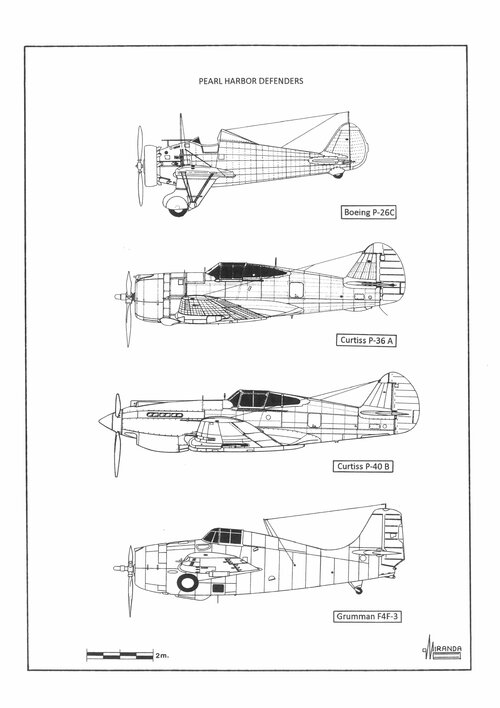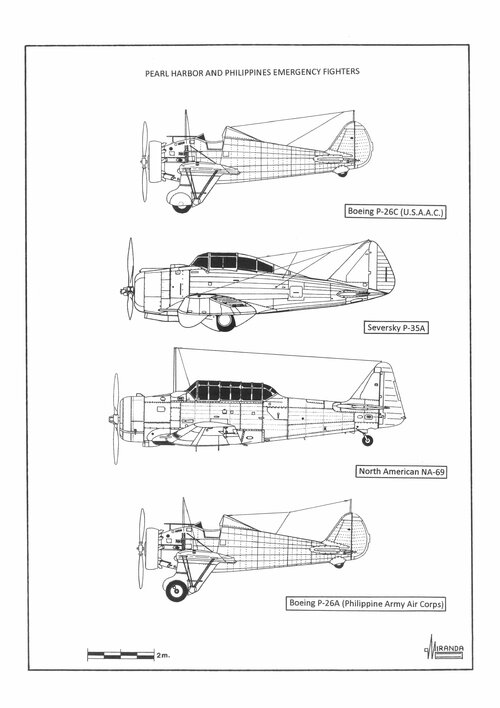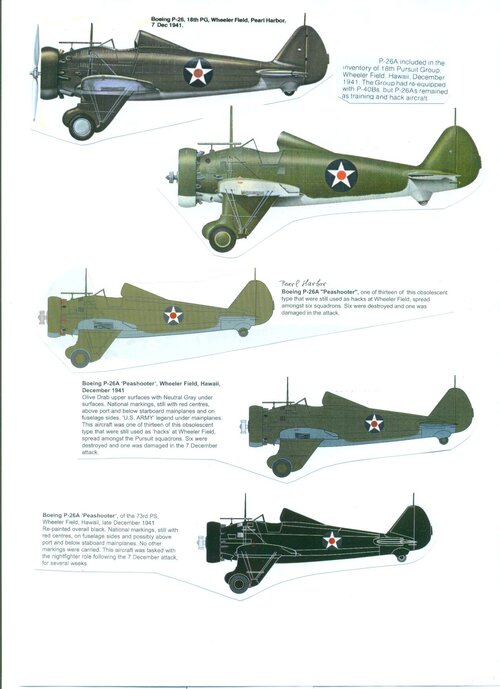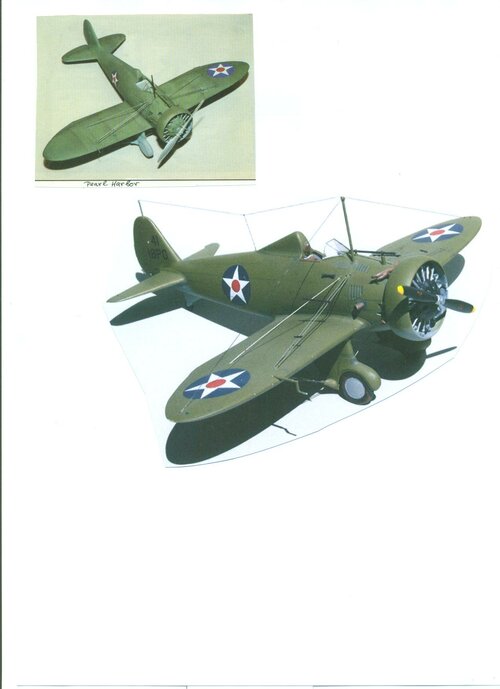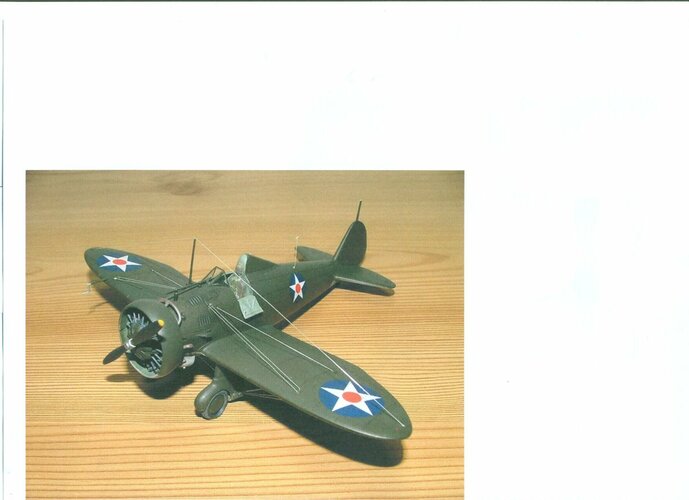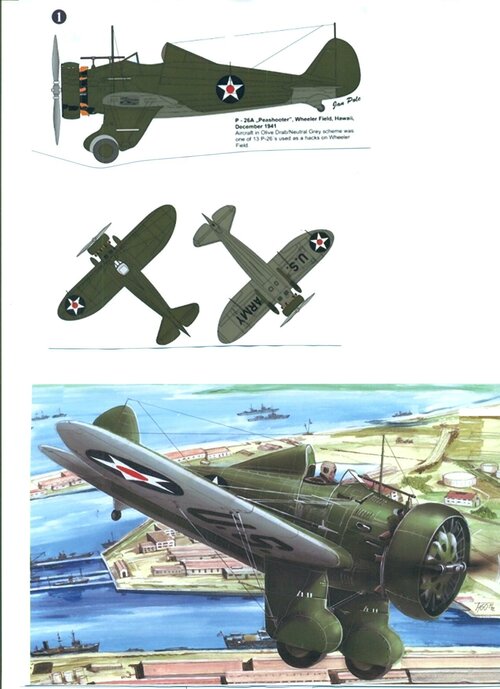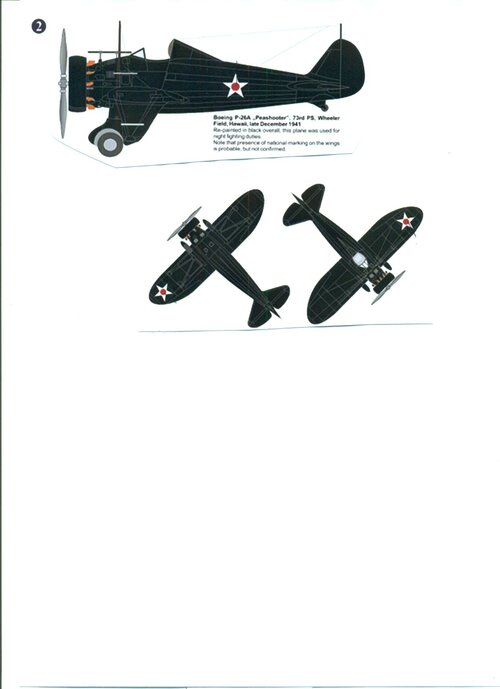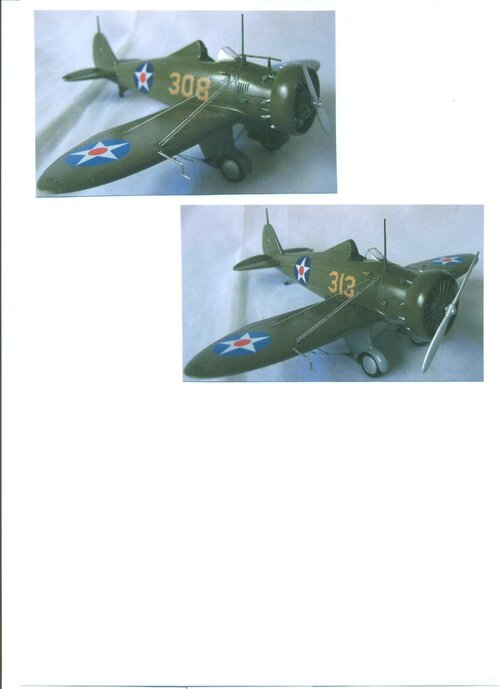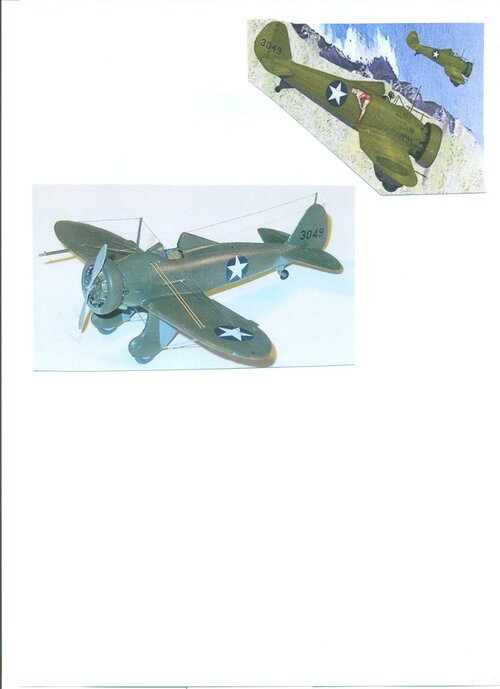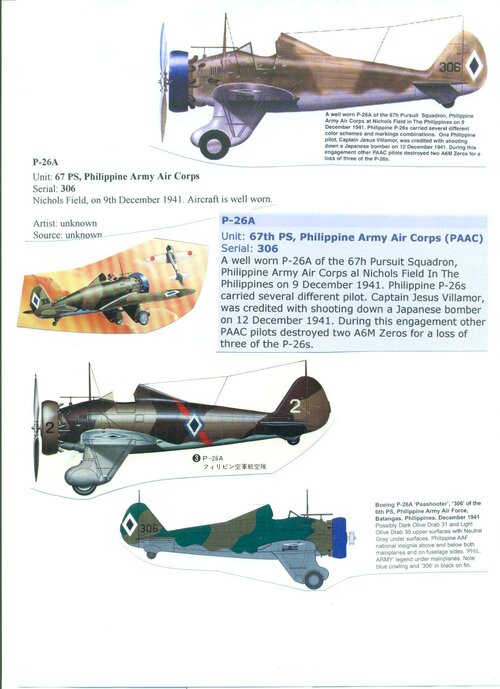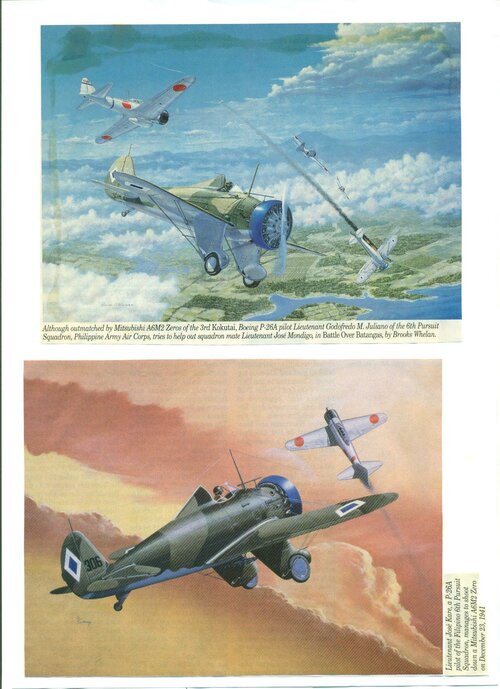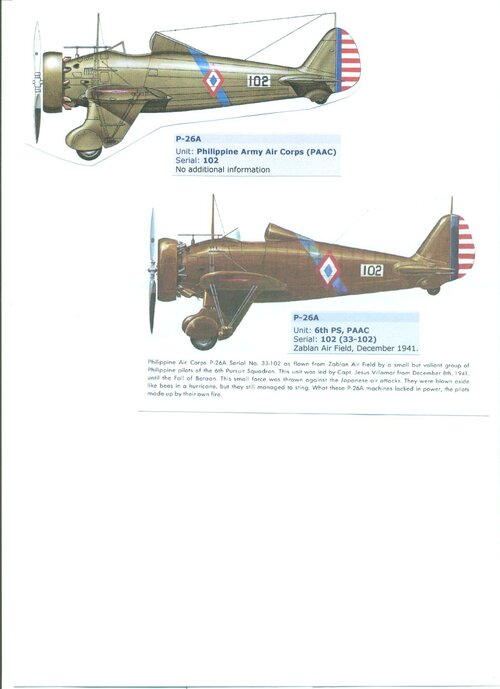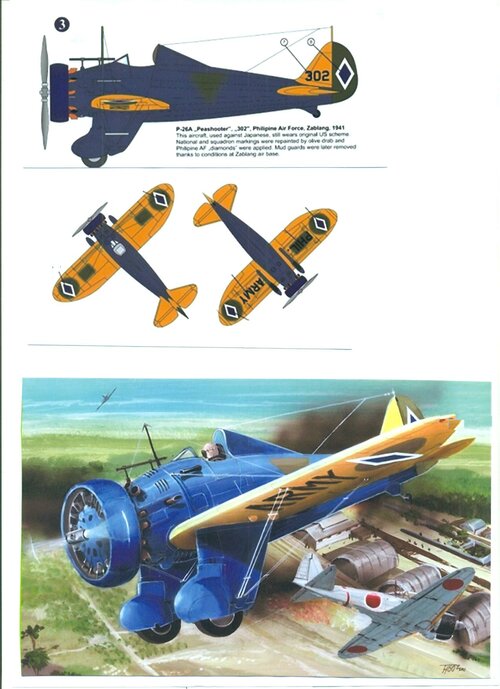Pearl Harbour (7 December 1941 to 4 March 1942)
On 7 December 1941 the American defences in Hawaii consisted of four Curtiss P-40C, eighty-five Curtiss P-40B, thirty-seven Curtiss P-36A, six Boeing P-26A and eight Boeing P-26C fighters based at Wheeler airfield, eight Curtiss P-40C and two Curtiss P-36A based at Haleiwa airfield, two Curtiss P-40B based at Bellows airfield, eleven Grumman F4F-3 based at Ewa Air Station, eight Brewster F2A-3, five Grumman F4F-3 and five Grumman F4F-3A based at Ford Island Air Station, together with five radar stations with SCR-270B sets.
After the Japanese attack, out of the 402 military aircraft in Hawaii, 188 were destroyed and 159 damaged.
On 8 December there were only eighteen P-40B, two P-40C, sixteen P-36A, six P-26A, six P-26C and three F4F-3 fighters in flying condition.
The Japanese Fleet still could operate with 311 aircraft and had been recovered 74 planes damaged but repairable. Fearing a third attack, the few fighters available in Hawaii were constantly in flight. However, they did not have IFF devices installed and the radar operators could not distinguish them from enemy aircraft. The visual detection depended on an Observer Corps, mainly integrated by civilian volunteers. The identification errors and continuous alarms raised the attrition rate of the aircraft and exhausted pilots.
In this situation the Americans decided to use the obsolete P-26, armed with one 0.50 in and one 0.30 in machine guns, as emergency night fighters.
Following the withdrawal of the Japanese Fleet, the P-26C, fitted with flaps and painted black, continued service to protect Pearl from long-range night intruders based in Marshall Islands. On 4 March 1942 three Kawanishi H8K1 flying boats from the Yokohama Kokutai, based in Wotje Island, attempted to bomb Pearl Harbor refuelling from a submarine at French Frigate Shoals. The attack was finally aborted due the poor visibility over Oahu and the P-26 lost the opportunity to fight.
Technical Data
Wingspan: 8,5 m; length: 7.15 m; height: 3.04 m; wing area: 13.4 sq.m; max weight: 1,585 kg; max speed: 379 kph; range: 1,000 km; power plant: one 600 hp Pratt & Whitney R-1340-33 air-cooled radial engine; armament: one 0.30 in and one 0.50 in machine guns in the cowl.
Bibliography
Books
Bowers, P., Boeing P-26, Aerofax Minigraph 8, 1964.
Bowers, P., Boeing Aircraft Since 1916, Naval Institute Press, 1989.
Davis, L., Boeing P-26, Squadron Signal In Action Mini Series Nº2, 1994.
Maloney, E., Boeing P-26 Peashooter, Aero Series 22, 1973.
Maloney, E., History of the Famous Boeing P-26 Peashooter, Challenge Publications Inc. 1965.
Publications
Green, W., “Boeing’s Fighter Finale, The Peashooter Chronicle”, Air Enthusiast/Fourteen.
Philippines (8 December 1941 to 9 April 1942)
Ten hours after the attack on Pearl Harbour, 107 Japanese naval bombers, escorted by 84 Zeros from Taiwan, carried out a devastating attack on Clark and Iba airfields, in the Island of Luzon. The bombing and subsequent strafing caused the destruction of nearly half of U.S. Far East Air Force, including fifteen Curtiss P-40E fighters and twelve Boeing B-17E heavy bombers.
The attackers were twenty-seven Mitsubishi G3M Nell and twenty-six Mitsubishi G4M Betty medium bombers, from Takao and Kanoya Kokutais, together with forty-two Mitsubishi A6M2 Zero-Sen from Tainan Kokutai.
The Japanese planes were tracked by the radar station at Iba and 18 fighters took off to intercept them, believing that they were heading to Manila. During the attack to Clark Field the control centre was destroyed, causing the complete breakdown of communications with other bases.
When the P-40E from 3rd Squadron returned to Iba for refueling, they found that the base was being attacked by fifty-four Bettys from Takao Kokutai and forty-two Mitsubishi A6M2 Zero-Sen that shot down five American fighters. At the same time, fifteen Nakajima B5N2 Kate bombers, escorted by three Mitsubishi A5M4 Claude fighters from IJN Ryujo carrier, attacked the naval bases at Davao and Mindanao destroying two PBY seaplanes.
The defence of the Philippines consisted of eighteen P-40E from 3rd Sqn, based at Iba Field, eighteen P-40E from 20th Sqn, based at Clark Field, eighteen P-40E, six P-35A and ten NA-69 from 17th Sqn, based at Nichols Field, eighteen P-40B from 21st Sqn, based at Nichols Field, eighteen P-35A from 39th Sqn, based at Del Carmen Field, and fourteen P-26A and two P-12E, from 6th Sqn of Philippine Army Air Corps, based at Batangas Field.
The fighters that survived the first attack were reserved for reconnaissance tasks, but on 13 and 16 December were forced to combat, suffering new losses. Eight days later only sixteen P-40 were serviceable on Bataan airfields. On 17 January 1942 there were only seven, on 14 February only four and only two by March. On 20 and 25 December 1941, the IJN Ryujo carrier supported the landings at Davao City and Jolo with sixteen Kates and twenty-two Claudes.
The involvement of the IJA during the first days of the invasion was limited by the short range of the ninety Nakajima Ki.27b fighters of the 4th, 24th and 50th Sentais, based in Taiwan, as they just provided air cover for amphibious assault forces operating to the North of 16 degrees latitude.
On 12 December, the 24th and 50th Sentais, with eighteen aircraft each, were based in Vigan and Aparri airfields, located in the North of Luzon Island. And the 27th Sentai was moved to Del Carmen airfield to support the offensive of Bataan escorting the Mitsubishi Ki.51 Sonia dive bombers.
Boeing P-26A 'Panic Fighter'
On November 1940 the USAAC had 28 of these obsolete aircraft in Philippines, attached to the 3rd and 17th Pursuit Squadrons based at Nichols and Clark airfields.
On April 1941 all Boeing fighters were transferred to the Philippine Army Air Corps. Attached to the 6th Pursuit Squadron based on Batangas Field, entering combat against Japanese planes on 10, 12, 14 and 23 December. Seven P-26 were shot down in the unequal struggle against the Zeros, although they were successful against the Mitsubishi G3M Nell on 12 December. The Filipino pilots continued the fight operating from Zablan Airfield until the fall of Bataan.
Technical Data
Wingspan: 8,5 m; length: 7.18 m; height: 3.04 m; wing area: 13.45 sq.m; max weight: 1,524 kg; max speed: 377 kph; range: 1,020 km; power plant: one 600 hp Pratt & Whitney R-1340-27 air-cooled radial engine; armament: two 0.30 in machine guns in the cowl.
Bibliography
Books
Munson, K., Fighters 1919-39, Blanford Press, 1970
Bowers, P., Aircraft in Profile, Volume 1, Number 14, Doubleday, 1965.
Crosby, F., Boeing P-26 Fighter Aircraft, Lorenz Books, 2002.
Shores, C., The Drift of War to the Fall of Singapore, Grub Street, 1992.
Wagner, R., American Combat Planes, Doubleday 1968.
Morton, L., The war of the Pacific, the fall of the Philippines. United States Army in the World War II, Center of Military History, United States Army.
Davis, L., Texan in Action, Squadron/Signal Aircraft Number 94, 2002.
Beauchamp, G., Curtiss P-40, Le Fanatique de l’Aviation Nº 130 to 147.
Bueschel, R., Nakajima Ki.27 A-B, Aircam Aviation Series Nº18, Osprey ,1972.
Bueschel, R., Mitsubishi A6M1/2/2N Zero-Sen, Aircam Aviation Series Nº16, Osprey ,1970.
Caidin, M., Zero Fighter, Ballantine’s, 1969.
Davis, L., P-35, Squadron/Signal Aircraft Mini Number 1, 1994.
Publications
Tremble, B., “Peashooter”, Scale Modeller Vol.9, Nº11, November 1974.
Dorr, R., “Boeing P-26 Peashooter”, Air International Vol.48, Nº4, 1995.

